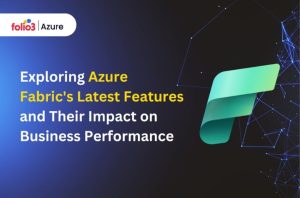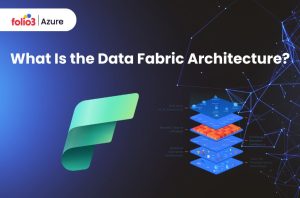Table of Contents
ToggleIntegrating modern data management and analytics technologies with your ERP systems is necessary in today’s increasingly data-driven business world. The services offered by Microsoft Fabric with Microsoft ERP consulting provide an extensive approach to enhancing your ERP system and enabling you to use data more effectively for improved decision-making and attaining business growth. Using Microsoft Fabric may revamp your data management and analytics procedures, dramatically improving how your company runs.
Consulting Approach to Enhancing ERP Systems
A consulting approach for ERP optimization consists of seeking consultancy
services provided by an ERP consultant adept in project management. They help your business select the most suitable ERP system and ERP system integration.
1. Assessment and Planning
Careful preparation and assessment are necessary before initiating the Microsoft Fabric integration process with your ERP system. This first stage involves assessing the ERP system you currently use and determining your company’s needs. The consultant will examine the current workflows, data structures, and problem areas throughout this phase. This can help create a detailed strategy that takes into account your unique needs.
Planning the integration and enhancement project involves setting clear goals and timelines. The consultant ensures everyone is on the same page by identifying key stakeholders and defining their roles. This stage also consists of a detailed risk assessment and reduction plan to handle possible challenges that may arise during the project.
An in-depth analysis will cover a gap analysis to spot areas where the current ERP system falls short and how Microsoft Fabric can bridge these gaps. This could involve analyzing data silos, inefficient processes, and obsolete technologies that restrict productivity. The aim is to chalk out a plan defining the steps necessary to attain a simplified integration, ensuring the transition is smooth and minimally disruptive for your regular operations.
In addition to these technical assessments, it is critical to fully understand the business environment and long-term goals. This involves interacting with important stakeholders in interviews to learn more about their expectations and identify any advantages the integration would bring. This in-depth understanding guarantees that the solution matches the company’s wider goals and is technically sound.
2. Implementation Steps
The implementation of Microsoft Fabric with Microsoft ERP systems is a multi-step process that requires careful execution. The first step is to incorporate data from multiple sources into Microsoft Fabric. This includes data from your ERP, CRM, and other external sources. Combining data into a collective platform allows you to organize and simplify data management and improve its accessibility.
In the next step, the target is to set up analytics within Microsoft Fabric. This includes configuring dashboards, reports, and other analytics tools to provide real-time data insights. Best practices for a successful implementation comprise ensuring data accuracy, maintaining data security, and maximizing the system performance.
During the implementation phase, it’s essential to adopt an iterative approach. An iterative approach means starting with a pilot project or a small-scale implementation to test the success of integration and resolve any issues before rolling it out to the whole organization. By adopting this strategy, you can refine the process, get feedback from users, and make necessary adjustments to ensure a successful full-scale deployment.
Each phase of the implementation should be documented carefully and thoroughly. This includes detailed project plans, timelines, resource allocations, and contingency plans. Clear communication with all stakeholders is mandatory to keep everyone in the loop and engaged throughout the process. Regular updates and status reports help monitor progress and handle any obstacles promptly.
3. Customization and Configuration
Customization and configuration are essential to ensure that Microsoft Fabric and your ERP system meet your particular business needs. This involves personalizing the system according to your workflows and business operations. Setting up dashboards and reports enables you to track key performance indicators (KPIs) and other crucial metrics for your operations.
Customizing Microsoft Fabric enables you to create a solution that matches and helps you with your long-term business goals. This includes setting up alerts and notifications for important business events, integrating AI-driven analytics for predictive insights, and ensuring that the system is user-friendly for your team.
For example, you can configure Microsoft Fabric to send real-time alerts when stock levels drop below a certain level, enabling you to take prompt action and prevent stockouts. Likewise, you can make intelligent decisions that lead to business growth by customizing reports to show sales trends and customer behavior. The ability to personalize Microsoft Fabric according to your unique requirements ensures you get the maximum benefits from the integration.
The customization process should also consider the solution’s scalability and flexibility. As your business grows and flourishes, the system should be able to adapt to new requirements without significant changes. The goal of safeguarding your future ensures that your investment in Microsoft Fabric and ERP integration for ERP optimization continues to reap benefits over the long run.
Integrating Microsoft Fabric with Microsoft ERP Systems
Microsoft ERP System Integration with Microsoft Fabric significantly benefits your organization and empowers you with solid features. Some of these are discussed below.
1. Connecting Data Sources
One of Microsoft Fabric’s significant strengths is its ability to merge various data sources simply and smoothly. This includes not only your ERP and CRM systems but also external data sources such as social media, financial data, and IoT devices. Connecting these multiple and spread data sources gives you a comprehensive view of your business operations.
For example, integrating social media data with your ERP system can give you in-depth knowledge about consumer attitudes and the latest market trends. In the same way, financial data integration can refine your financial reporting and compliance processes. This all-encompassing data integration ensures that you have access to correct and up-to-date information for intelligent decision-making.
Addressing data compliance and safety requirements is another essential component of connecting data sources. This involves implementing strong data management procedures to guarantee data security, privacy, and integrity. By adhering to industry norms and laws, you may reduce risks and gain stakeholders’ trust.
2. Data Management and Analytics
Microsoft Fabric offers powerful Data Management Solutions with intense data cleansing, transformation, and storage features. These capabilities can ensure that your data is accurate, consistent, and ready for analysis. Data cleansing consists of removing duplicates, rectifying errors, and standardizing data formats. This step is mandatory for maintaining data quality and reliability.
Modern analytics and AI are essential components of Microsoft Fabric. These powerful tools allow you to dig deeper into your business operations and gain valuable data.
For example, predictive analytics can assist you in forecasting future trends, while machine learning algorithms can spot patterns and abnormalities in your data. These insights enable you to make data-driven decisions that accelerate business growth and competitiveness.
Microsoft Fabric provides advanced data visualization tools in addition to standard analytics. These visualizations help simplify and improve the use of complex data. Intuitive data presentation formats like interactive dashboards, graphs, and charts may enhance decision-making and successfully communicate insights to stakeholders.
3. Real-Time Data Insights
The ability to access real-time data insights is an important edge gained by integrating Microsoft Fabric with your ERP system for ERP modernization. Real-time data integration and analysis equip you with up-to-date information about your business performance. This is highly valuable for industries that need prompt decision-making, such as retail, manufacturing, and finance.
Real-time metrics and KPIs allow you to keep a keen eye on your operations and respond quickly to any issues or opportunities. For example, real-time sales data can help you alter your marketing strategies, while real-time inventory data can maximize your supply chain management. By having access to critical information, you can boost efficiency and stay ahead of the competition.
Real-time analytics further supports proactive management. This consists of identifying possible problems and resolving them before they become more serious. For instance, manufacturers may plan maintenance before a breakdown takes place and save downtime and maintenance expenses by monitoring equipment performance in real-time.
Conclusion
Enhancing your Fabric with Microsoft ERP consulting leads to immense benefits, from improved data management to advanced analytics and real-time insights. A consulting approach ensures that the integration is customized to match your specific needs, providing a personalized solution that boosts your business operations.
By following an organized consulting approach that includes assessment and planning, implementation, and customization, you can gain ERP optimization and benefit from the full potential of Microsoft Fabric. This comprehensive integration not only modernizes your ERP system but also braces your business for future growth, success, and maintenance of a competitive edge.
For more insights and guidance on integrating Microsoft Fabric with your ERP system, visit our Azure Data Analytics page. Here, you’ll find additional resources and consulting services to help you initiate your data management and analytics journey for business success!


